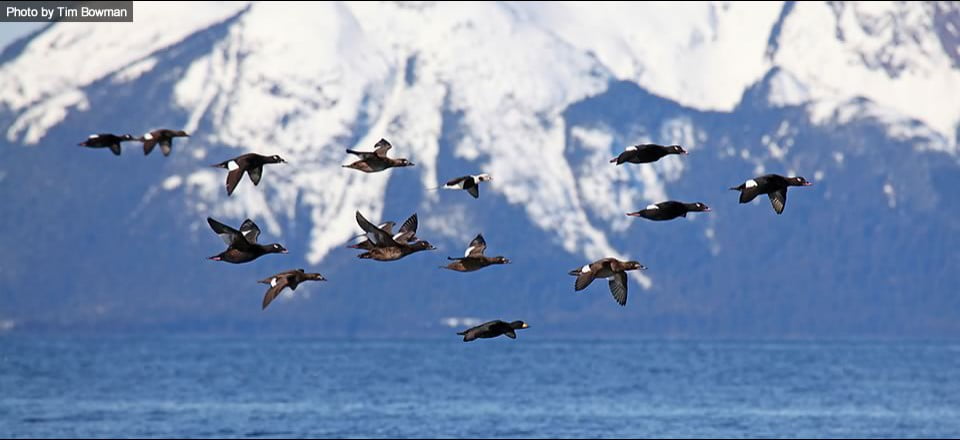Lead Institution(s): Simon Fraser University
Collaborator(s): Jenn Barrett (SFU), John Hodges (USFWS), Bruce Conant (USFWS), Jerry Hupp (USGS), Daniel Esler (SFU), Kristina Rothley (SFU)
Focal Species: All Sea Ducks, Bufflehead (Bucephala albeola), Barrow’s Goldeneye (Bucephala islandica), Common Goldeneye (Bucephala clangula), Harlequin Duck (Histrionicus histrionicus), Long-tailed Duck (Clangula hyemalis), Common Eider (Somateria mollissima), King Eider (Somateria spectabilis), Spectacled Eider (Somateria fischeri), Steller’s Eider (Polysticta stelleri), Common Merganser (Mergus merganser), Hooded Merganser (Lophodytes cucullatus), Red-breasted Merganser (Mergus serrator), Black Scoter (Melanitta americana), Surf Scoter (Melanitta perspicillata), White-winged Scoter (Melanitta delgandi)
Project Description: Southeast Alaska (Figure 1) provides winter habitat for at least 10 species of sea ducks totaling >300,000 individuals, making the region one of the most important sea duck wintering areas in the Pacific Flyway. In summer the region provides molting habitat for large numbers of scoters, mergansers, and harlequin ducks. The U.S. Fish and Wildlife Service (USFWS) conducted winter surveys of sea duck abundance in Southeast Alaska in 1996 (Anonymous 1996). Hodges et al. (2008) provided estimates of summer and winter sea duck distribution and abundance based on aerial surveys of most shorelines and adjacent nearshore waters in Southeast Alaska from 1997-2002. We summarized aerial survey data collected by the USFWS between 1996 and 2002 using a Geographic Information System (GIS) to evaluate regional patterns of sea duck diversity and abundance, consistency in use of sites between years and seasons, and habitat attributes associated with sea duck presence in Southeast Alaska.
SDJV86 Interim Report FY07
SDJV86 Interim Report FY08
SDJV86 Final Report
Related Publications
Gunn, T. 2009. Habitat Correlates of Wintering Sea Duck Occurrence in Southeast Alaska. M.Sc. Thesis. Simon Fraser University, Burnaby, British Columbia. https://summit.sfu.ca/_flysystem/fedora/sfu_migrate/9474/etd4467.pdf
